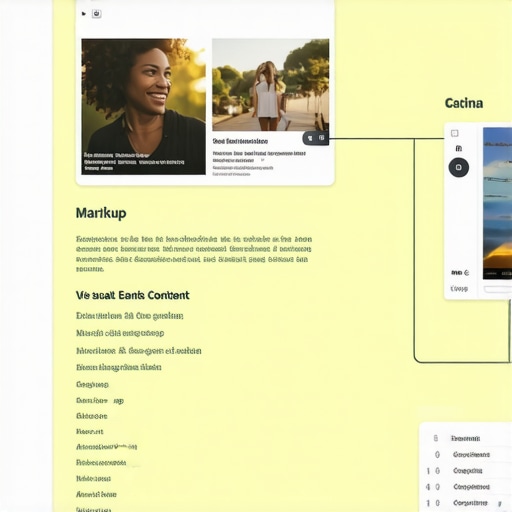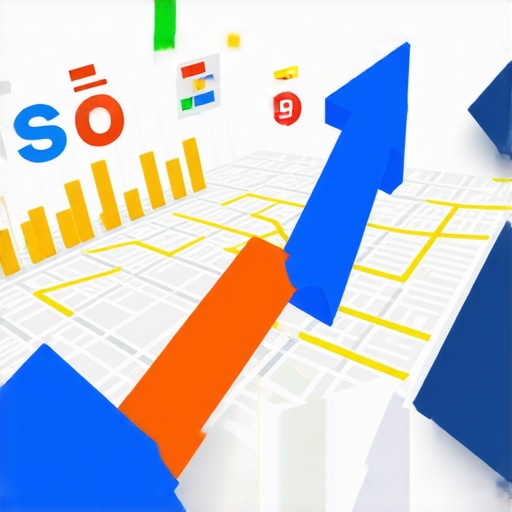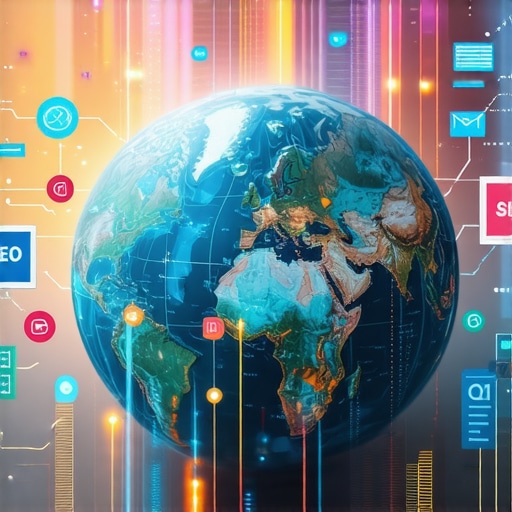Unlocking the Depths of Google Visibility and Maps SEO in 2024
In an era where local search dominance is pivotal for business growth, understanding the intricate mechanics of Google visibility and Maps SEO becomes essential for digital strategists and seasoned marketers. As competition intensifies, the question isn’t merely about ranking but about cultivating a resilient, expert-level presence that sustains in the dynamic landscape of 2024.
Advanced Strategies for Elevating Google Maps SEO in Competitive Markets
How can businesses leverage semantic SEO to outperform local competitors?
Semantic SEO transcends traditional keyword stuffing, emphasizing context and user intent. By optimizing Google My Business profiles with rich, semantically relevant content—such as detailed service descriptions, FAQs, and localized keywords—businesses can enhance their relevance. Integrating structured data markup, like Schema.org, further signals contextual authority to Google, reinforcing visibility in local searches and map pack rankings.
Integrating Niche-Specific SEO Techniques for 2024
Emerging SEO techniques involve leveraging user-generated content and reviews to bolster trust signals and authority. According to research from BrightLocal, review quantity and quality significantly influence local rankings. Implementing review solicitation strategies and actively managing reputation can be game-changers. Moreover, optimizing for voice search and mobile-first indexing demands nuanced keyword targeting—favoring conversational queries and long-tail phrases rooted in user behavior analysis.
Complexity of Local Link Building and Citation Management
Building authoritative local backlinks remains a cornerstone, yet it requires a sophisticated approach. Engaging with local industry associations, sponsoring community events, and creating valuable local content can facilitate natural link acquisition. Concurrently, citation consistency across platforms like Yelp, TripAdvisor, and industry-specific directories ensures Google’s trust in your business data, directly impacting local pack rankings.
Key Technical SEO Elements for Maps Optimization
Technical SEO intricacies, such as website speed, mobile responsiveness, and structured data accuracy, play a pivotal role in Maps SEO. Ensuring your website aligns with Google’s Core Web Vitals can improve overall search rankings. Implementing hreflang tags for multi-region targeting further refines visibility, especially for geographically diverse businesses.
Expert Insights and Open Challenges in Google Maps SEO
One pressing question among experts is: How does Google’s evolving algorithm balance user engagement signals with traditional SEO metrics in local search rankings? The debate centers on whether behavioral metrics like click-through rates, dwell time, or social signals will increasingly influence local pack rankings. While Google maintains that relevance and authority are primary, emerging data suggests a nuanced interplay that requires ongoing adaptation.
To stay ahead, professionals should continually monitor algorithm updates via sources like Search Engine Land and participate in community forums such as Google’s Webmaster Help Community. Sharing insights and case studies enhances collective understanding and fosters innovative strategies.
For more expert-level tactics, explore our comprehensive guide on effective Google visibility tips for improved Maps SEO, and consider contributing your own insights to the evolving discourse.
Harnessing AI and Machine Learning to Refine Local Search Strategies
As Google continues to integrate artificial intelligence and machine learning into its algorithms, savvy local SEO professionals are exploring innovative ways to adapt. AI-driven tools can analyze vast amounts of user interaction data, helping businesses identify emerging local search trends and optimize their Google My Business profiles accordingly. For instance, leveraging AI-based keyword research tools allows for the discovery of long-tail, conversational queries that are increasingly prevalent in voice searches, aligning with the shift toward mobile-first and voice-activated searches.
Which Strategies Are Experts Overlooking in Local SEO Optimization?
One often underappreciated aspect is the role of hyper-local content tailored to micro-moments within your community. Creating content that addresses specific local events, seasonal trends, or community issues can significantly boost relevance signals to Google. Additionally, integrating structured data markup for local businesses, such as detailed service schema and event markup, enhances your profile’s visibility in rich snippets and map packs.
Visual content showcasing an example of optimized local schema markup implementation can clarify complex technical strategies and inspire practical application.
Are Your Local SEO Tactics Future-Proof Against Algorithm Shifts?
Staying ahead in local search requires a proactive approach to algorithm updates and emerging ranking factors. Regularly auditing your local SEO practices against the latest Google guidelines, participating in industry forums, and engaging with community feedback are vital. According to Moz’s 2024 local search ranking factors report, signals like user reviews, NAP consistency, and behavioral metrics are gaining increased importance, emphasizing the need for a holistic optimization approach. For a comprehensive understanding of how to adapt, visit this resource.
If you’re eager to deepen your expertise, consider exploring our detailed guide on top Maps SEO techniques for 2024 and share your insights in the comments to contribute to the community’s growth.
Harnessing the Power of Local Entity Optimization for Unparalleled Visibility
In the rapidly evolving landscape of local SEO, one of the most sophisticated strategies involves optimizing for local entities rather than just keywords. Google’s algorithm increasingly recognizes businesses, landmarks, and community organizations as distinct entities with rich semantic relationships. By creating a comprehensive entity profile—integrating Google My Business with structured data, Wikipedia entries, and authoritative local directories—you signal to Google a cohesive, authoritative local presence that surpasses traditional keyword-based tactics.
What are the implications of entity-based SEO for Google Maps rankings?
Entity-based SEO leverages Google’s Knowledge Graph and semantic understanding, allowing your business to appear in rich results, Knowledge Panels, and local packs even for less competitive queries. This approach requires meticulous management of your business’s digital footprint, including schema markup, NAP consistency, and authoritative backlinks from trusted local sources. According to Moz’s 2024 Local Search Ranking Factors, entities and semantic relevance now weigh heavily in local algorithm calculations, emphasizing the need for a holistic, data-driven approach.
Integrating Advanced Behavioral Signals for Dynamic Ranking Adaptation
While traditional SEO metrics like backlinks and citations remain vital, Google increasingly considers behavioral signals—such as dwell time, bounce rates, and engagement metrics—to evaluate local search relevance. To leverage this, businesses should focus on creating engaging, locally relevant content that encourages user interaction. Implementing interactive maps, virtual tours, and customer testimonial videos can significantly enhance dwell time and user engagement, thus positively influencing local rankings.
Furthermore, integrating AI-powered analytics tools enables real-time monitoring of these behavioral signals. For instance, platforms like BrightEdge or SEMrush now offer insights into user interactions, allowing for rapid content and strategy adjustments that align with evolving search patterns.
How can local businesses leverage AI-driven personalization to boost Maps SEO?
AI-driven personalization tailors search results based on user behavior, preferences, and context. By analyzing local user data—such as frequently visited landmarks, preferred service categories, and time-of-day patterns—businesses can optimize their Google My Business content, reviews, and local keywords to match user intent more precisely. This hyper-local, personalized approach enhances the likelihood of appearing in the coveted map pack and local snippets, especially in competitive markets.
Deepening Your Local Link Network with Strategic Partnership Building
Beyond traditional link building, fostering strategic partnerships within your community can generate high-quality backlinks and citations that Google perceives as trust signals. Partnering with local educational institutions, chambers of commerce, and industry associations not only provides backlinks but also positions your business as an active community stakeholder. Creating co-branded content, sponsoring local events, or hosting workshops can organically generate valuable local links and boost your authority in Google’s eyes.
Moreover, leveraging local PR campaigns and press releases about community impact or innovative projects can attract media coverage, resulting in authoritative backlinks that significantly enhance your local SEO profile.
Why is citation consistency more critical than ever in 2024?
In 2024, Google’s algorithms place heightened importance on citation consistency across all platforms. Discrepancies in your NAP data (Name, Address, Phone number) across directories, review sites, and social media can diminish trust signals and lower your local pack rankings. Regular audits using tools like Moz Local or Whitespark ensure that your data remains uniform and accurate, reinforcing your business’s credibility and visibility.
Innovating with Voice Search and Multimodal Optimization
The proliferation of voice-activated devices and multimodal search interfaces demands a forward-thinking approach. Optimizing for natural language queries, local conversational questions, and multimodal content formats—such as images, videos, and augmented reality—can position your business at the forefront of voice search results.
For example, incorporating long-tail, question-based keywords into your Google My Business posts and FAQs aligns well with voice search patterns. Additionally, creating visually rich content that can be easily indexed by Google Lens or similar technologies enhances your chances of appearing in multimodal search results.
Engaging with these emerging trends requires a continuous cycle of testing, analyzing, and refining your strategies—an approach that only seasoned SEO professionals master through ongoing education and experimentation. To take your local SEO mastery further, consider exploring detailed case studies and tools like SEMrush’s Local SEO toolkit or BrightLocal’s review management dashboard.
Harnessing the Power of Semantic Entities for Enhanced Local Visibility
In the complex landscape of local SEO, transitioning from keyword-centric tactics to entity-based optimization represents a paradigm shift. Google’s Knowledge Graph increasingly recognizes businesses as interconnected entities, which necessitates a comprehensive approach encompassing structured data, authoritative citations, and semantic relationships. By cultivating a robust entity profile through integrations with Wikipedia, local directories, and schema markup, businesses can significantly elevate their prominence in local packs and rich snippets.
Can Behavioral Signals Outweigh Traditional SEO Metrics in Local Search?
Emerging research indicates that user engagement metrics—such as dwell time, bounce rates, and click-through ratios—are gaining prominence in Google’s ranking algorithms. Advanced local SEO strategies now emphasize creating engaging, contextually relevant content that encourages interaction. Implementing dynamic elements like virtual tours, interactive maps, and customer testimonial videos not only enhances user experience but also positively influences behavioral signals, thereby improving local rankings.
External Authority and the Role of Niche Community Linkages
Building on traditional local backlinks, integrating strategic partnerships with community organizations, educational institutions, and industry associations fosters high-quality link acquisition. These collaborations serve as trust signals to Google, reinforcing local relevance and authority. Additionally, curated local PR campaigns and event sponsorships can generate media coverage and backlinks, further strengthening your local SEO footprint.
How does Multimodal Content Optimization Impact Voice Search Performance?
With the surge in voice-activated assistants and multimodal search interfaces, optimizing for natural language and visual content is crucial. Incorporating long-tail, question-based keywords into your Google My Business posts and FAQs aligns with voice query patterns. Furthermore, developing visually rich content—such as images, videos, and AR experiences—enhances indexation by Google Lens and similar technologies, positioning your business at the forefront of multimodal search results.

Illustrative image showcasing a business’s schema markup implementation and multimodal content integration, emphasizing advanced SEO tactics.
What Are the Future Implications of AI-Driven Personalization in Local SEO?
AI-powered personalization enables hyper-local targeting by analyzing user preferences, behaviors, and contextual data. This sophisticated approach allows businesses to tailor their Google My Business content, reviews, and local keywords to match individual user intents more precisely. As a result, the likelihood of appearing in the coveted map pack increases, especially in competitive markets. Leveraging predictive analytics and AI-driven tools like SEMrush’s Local SEO suite can help in continuous optimization based on evolving user patterns.
Engage with Cutting-Edge Local SEO Techniques Today
Staying ahead in Google Maps SEO requires embracing innovative strategies rooted in entity optimization, behavioral insights, and multimodal content. Regularly updating your knowledge through authoritative sources such as Search Engine Land and active participation in SEO communities will ensure your tactics remain effective amid algorithm updates. Implement these advanced insights to secure a resilient, high-visibility local presence in 2024 and beyond.
Expert Insights & Advanced Considerations
1. Embrace Entity Optimization to Leverage Google’s Knowledge Graph
Focusing on local entity profiles and rich semantic relationships enhances visibility in local packs and rich snippets, positioning your business as a trusted authority in your community.
2. Prioritize Behavioral Signal Enhancement through Interactive Content
Creating engaging virtual tours, customer testimonials, and interactive maps can significantly boost dwell time and engagement metrics, influencing rankings in your favor.
3. Harness AI-Driven Personalization for Hyper-Local Targeting
Utilize AI analytics to understand user preferences and behaviors, tailoring your Google My Business content and reviews to align with individual search intents, especially in competitive markets.
4. Develop a Robust Local Link Network via Strategic Partnerships
Collaborate with local organizations, educational institutions, and industry groups to gain high-quality backlinks and citations, reinforcing your local authority and trustworthiness.
5. Optimize for Multimodal Search and Voice Queries
Incorporate natural language keywords, rich media content, and AR elements to adapt to voice-activated and multimodal search trends, ensuring your visibility across various platforms and devices.
Curated Expert Resources
- Search Engine Land: A comprehensive source for the latest industry updates, algorithm changes, and strategic insights tailored for SEO professionals.
- Moz’s Local Search Ranking Factors: An authoritative report detailing the evolving metrics influencing local SEO success in 2024.
- BrightLocal Blog: Offers in-depth case studies, review management strategies, and actionable tips for advanced local SEO tactics.
- SEMrush Local SEO Toolkit: A suite of AI-powered tools for keyword research, competitor analysis, and local ranking monitoring, essential for data-driven SEO.
- Google’s Official Blog: For direct updates, best practices, and insights into Google’s evolving algorithms and local search innovations.
Final Expert Perspective
Mastering Google Maps SEO in 2024 demands a sophisticated, multi-layered approach that integrates entity optimization, behavioral analytics, and emerging multimodal technologies. By continuously refining strategies through authoritative resources and leveraging AI-driven insights, seasoned professionals can secure a resilient, high-visibility presence that outperforms competitors. Engage with these advanced insights, contribute your expertise, and stay ahead in the ever-evolving landscape of local search excellence.




